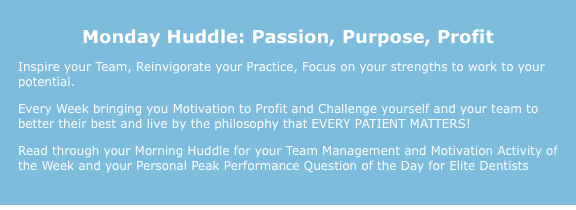It’s always with the best of intentions… but you know where those get you, now don’t ya.
This is perhaps the biggest flaw that is all too common with every Doctor’s engagement with a patient. It comes in different shapes and sizes with each different approach to communication but the end result is all the same.
If you can break your doctor’s habit of this, you will be on your way to much stronger and more committed “clinical yeses” and you will be able to secure a greater percentage of case acceptance without having to fight with patients over money.
It is not diminishing treatment (although that is the most basic issue many doctors and team members have). Diminishing treatment is taking something that is larger and making it smaller for fear of the patient being overwhelmed, not being able to pay for it or that they won’t have the interest in all of it. As we always talk about: LET THEM DECIDE. Stop trying to decide for them. If you give your patients a chance to say yes, you will be surprised at how often they do.
But it gets worse than this; as this flaw is an even bigger, more advanced problem than diminishing the treatment.
It is diminishing THE VALUE (or significance or importance) of the Treatment.
Read that again because in that one sentence lies everything. This is your ultimate secret for getting patients to want to fight to find ways to pay you and to complete treatment versus fight against ways to find money and to avoid treatment.
Doctors do this all the time, usually without even knowing it. You may even let them because you have become immune to it and don’t even catch it when it’s said.
I’m talking about when you make the patient feel like…
“It’s not that big of a deal.” “It’s not that bad.” “It could be worse.”
Or dozens of other statements that are made to take a problem that the patient has and the treatment solution you are presenting for it and making it seem like it is less of a priority than it should be.
Every doctor and every team member are guilty. You do this to make them feel better, to try to relieve them from feeling guilt or embarrassment, to make it not seem expensive, or insert whatever excuse you have (any of which don’t matter).
You see, they aren’t supposed to feel better until they get the treatment and fix the problem. Diagnosing a problem and then telling the patient it really isn’t a problem, doesn’t help anyone get healthy.
When you do anything that goes against the urgency, significance, importance, value, benefit or potential consequence – you are letting the patients remain in an unhealthy state and training them to wait until it’s worse.
It is okay to reassure a patient that it’s going to be fine BECAUSE…
It is not going to be a very complicated procedure BECAUSE
The great news is that it’s not as bad as it could be BECAUSE
You and I – Patient and Doctor – ARE DOING SOMETHING ABOUT IT.
You have to tie the positive to the desirable action that helps the patient the most. It’s simple but so incredibly powerful. This is the psychology that compels a patient to want to proceed with treatment and get healthy.
Do not let your patients off the hook by making the problems in their mouths trivial and do not diminish the value of what you are presenting as the solution by making it seem optional.
Really pay attention and critique each other to help one another get better and develop muscle memory around this. Always connect the positive to the desired action.
You don’t have to (and shouldn’t) over embellish anything, but you must not diminish it either. The patient is looking to you for any reason, even the slightest justification, to avoid, delay, deny or wait a little longer.
That isn’t in their best interests – you know, after all, because you’re the professionals. You are here to help them do what is in their best interests based on their true current state of health.
To be continued…



